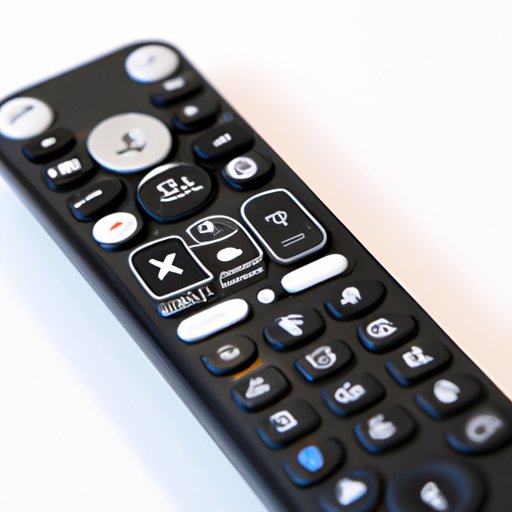
I. Introduction
Apple TV is a digital media player that allows you to stream movies, TV shows, and music from your favorite apps like Netflix, Hulu, and Amazon Prime Video. It is a popular option for those looking to enhance their home entertainment experience. However, using Apple TV without a remote can be cumbersome and frustrating. This is where pairing a remote with Apple TV comes in handy. In this article, we will provide a step-by-step guide on how to pair a remote with Apple TV and troubleshoot common problems.
II. Step-by-Step Guide: How to Pair a Remote with an Apple TV
Before beginning the pairing process, make sure that your Apple TV is turned on and connected to your television. You will also need a compatible remote, such as an Apple TV remote or Siri remote, and a charged battery.
To pair a remote with Apple TV:
- Go to the settings menu on your Apple TV and select “Remotes and Devices.”
- Select “Bluetooth” and enable it.
- Hold down the “Menu” and “Volume Up” buttons simultaneously on your remote until the pairing icon appears on your screen.
- Wait for your Apple TV to detect the remote. Once it does, click “Pair” on the screen.
- Your remote should now be successfully paired with your Apple TV. Test the buttons to make sure they’re working correctly.
To make the pairing process easier, make sure your remote is close to your Apple TV and that there are no obstructions between them. If you’re still having trouble, try restarting your Apple TV or removing and reinserting the batteries from your remote.
III. Troubleshooting Tips for Pairing Remote with Apple TV
Despite your best efforts, you may encounter issues when pairing your remote with Apple TV. Here are some common problems and solutions:
- The remote isn’t being detected by your Apple TV: Restart your Apple TV and try pairing the remote again. Also, make sure that you’re holding down the proper buttons when attempting to pair the remote.
- The pairing icon doesn’t appear on your screen: Make sure that your Bluetooth is enabled on both the remote and your Apple TV. Also, ensure that your batteries are charged and that the remote is close to your Apple TV.
- The remote buttons aren’t working: Ensure that the batteries are inserted correctly and that they are fully charged. Try resetting your remote by holding down the “Menu” and “Volume Up” buttons simultaneously for six seconds.
IV. Video Tutorial: Walking Through the Process of Pairing a Remote with Apple TV
If you’re more of a visual learner, consider watching a video tutorial on pairing your remote with Apple TV. Many options are available on Youtube that can provide an in-depth and easy-to-follow guide.
The benefits of using a video tutorial are that you can see the process being done while also following along on your own. This option helps ensure that you’re doing the right steps and makes the process less daunting.
V. Comparison of Remote Options: Siri Remote vs. Apple TV Remote
There are two types of remotes you can use to pair with Apple TV:
- Siri Remote: This remote has a touchpad that allows you to easily navigate and select content. The “Siri” button also enables voice control, which allows you to search for content and control playback using voice commands.
- Apple TV Remote: This remote is more conventional, with arrow buttons and main menus that you can scroll through to access content. It also has a “Menu” button, which serves as a go-back function.
In terms of functionality, the Siri remote is more advanced, allowing for voice control and touchpad navigation. However, the Apple TV remote is more straightforward and can be easier to navigate for those who prefer button control over voice commands.
If you’re a fan of voice-controlled features and don’t mind the touchpad navigation, the Siri remote might be your better option. If you prefer more traditional navigation and button control, the Apple TV remote is a great choice.
VI. Benefits of Pairing a Remote with Apple TV
Pairing a remote with Apple TV provides numerous benefits. It increases ease-of-use, allowing you to navigate and select content with ease and convenience. Additionally, remotes allow for additional features that can enhance the viewing experience, such as voice control and touchpad navigation with the Siri remote.
By pairing a remote with Apple TV, you’re getting the most out of the digital media player and maximizing the entertainment experience.
VII. Highlighting Advanced Features: Explore the Possibilities
With a paired remote, you can access advanced features that many Apple TV users may overlook. One of these features is voice control, which allows you to search for content using voice commands. This feature is especially handy when browsing for content with words that are challenging to spell or search efficiently.
Another advanced feature of the Siri remote is touchpad navigation. Instead of relying on arrows or buttons to navigate menus, the touchpad allows for more natural and intuitive navigation. If you’re a fan of the swipe and tap functions that are standard on most smartphones, touchpad navigation will feel familiar and effortless.
VIII. Conclusion
Pairing a remote with Apple TV takes a little bit of effort but pays off in convenience, increasing the ease and enjoyment of the viewing experience. By following our step-by-step guide, you can pair your remote quickly and troubleshoot any problems that may arise.
If you haven’t paired your Apple TV remote yet, we encourage you to try it out and take advantage of the additional features a remote can provide. By considering the advanced features and comparing available remote options, you can select the best remote for your unique needs and viewing preferences.




